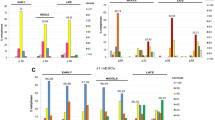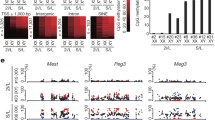Abstract
Mouse embryonic stem (ES) cells are widely used in early development studies and for transgenic animal production; however, a stable karyotype is a prerequisite for their use. We derived 32 ES cell lines of outbred mice (129 × BALB (1B), C57BL × 1B, and DD × 1B F1 hybrids). Pluripotency was assessed by utilizing stem-cell-marker gene expression, teratoma formation assays and the formation of chimeras. It was shown that only 21 of the 32 ES cell lines had a diploid modal number of chromosomes of 40. In these lines, the percentage of diploid cells varied from 30.3 to 78.9 %, and trisomy of chromosomes 1, 8 and 11 was observed in some cells in 16.7, 36.7 and 20.0 % of the diploid ES cell lines, respectively. Some cells had trisomy of chromosomes 6, 9, 12, 14, 18 and 19. In situ hybridization with an X chromosome paint probe revealed that 7 of the 11 XX-cell lines had X chromosome rearrangements in some cells. Analysis of the methylation status of the Dlk1-Dio3 locus showed that imprinting was altered in 4 of the 18 ES cell lines. Thus, mouse ES cell lines are prone to chromosome abnormalities even at early passages. Therefore, routine cytogenetic and imprinting analyses are necessary for ES cell characterization.



Similar content being viewed by others
References
Battulin NR, Khabarova AA, Boyarskikh UA, Menzorov AG, Filipenko ML, Serov OL (2012) Reprogramming somatic cells by fusion with embryonic stem cells does not cause silencing of the Dlk1-Dio3 region in mice. World J Stem Cells 4:87–93
Ben-David U, Benvenisty N (2012) High prevalence of evolutionarily conserved and species-specific genomic aberrations in mouse pluripotent stem cells. Stem Cells 30:612–622
Boheler KR (2003) ES cell differentiation to the cardiac lineage. In: Wassarman PM, Keller GM (eds) Differentiation of embryonic stem cells, vol 365. Academic Press, USA, p 233
Bryja V, Bonilla S, Cajánek L, Parish CL, Schwartz CM, Luo Y, Rao MS, Arenas E (2006) An efficient method for the derivation of mouse embryonic stem cells. Stem Cells 24:844–849
Choppa PC, Vojdani A, Tagle C, Andrin R, Magtoto L (1998) Multiplex PCR for the detection of Mycoplasma fermentans M. hominisand and M. penetrans in cell cultures and blood samples of patients with chronic fatigue syndrome. Mol Cell Probes 12:301–308
Cockburn K, Rossant J (2010) Making the blastocyst: lessons from the mouse. J Clin Invest 120:995–1003
da Rocha ST, Edwards CA, Ito M, Ogata T, Ferguson-Smith AC (2008) Genomic imprinting at the mammalian Dlk1-Dio3 domain. Trends Genet 24:306–316
Eggan K, Akutsu H, Loring J, Jackson-Grusby L, Klemm M, Rideout WM III, Yanagimachi R, Jaenisch R (2001) Hybrid vigor, fetal overgrowth, and viability of mice derived by nuclear cloning and tetraploid embryo complementation. Proc Natl Acad Sci USA 98:6209–6214
Eggan K, Rode A, Jentsch I, Samuel C, Hennek T, Tintrup H, Zevnik B, Erwin J, Loring J, Jackson-Grusby L, Speicher MR, Kuehn R, Jaenisch R (2002) Male and female mice derived from the same embryonic stem cell clone by tetraploid embryo complementation. Nat Biotechnol 20:455–459
Evans M, Kaufman M (1981) Establishment in culture of pluripotent cells from mouse embryos. Nature 292:154–156
Guo J, Jauch A, Heidi HG, Schoell B, Erz D, Schrank M, Janssen JW (2005) Multicolor karyotype analyses of mouse embryonic stem cells. In Vitro Cell Dev Biol Anim 41:278–283
Hogan B, Beddington R, Constantini F, Lacey E (1994) Manipulating the mouse embryo, 2nd edn. Cold Spring Harbor Laboratory Press, New York, p 497
Li X, Wei W, Yong J, Jia Q, Yu Y, Di K (2005) The genetic heterozygosity and fitness of tetraploid embryos and embryonic stem cells are crucial parameters influencing survival of mice derived from embryonic stem cells by tetraploid embryo aggregation. Reproduction 130:53–59
Liu X, Wu H, Loring J, Hormuzdi S, Disteche CM, Bornstein P, Jaenisch R (1997) Trisomy eight in ES cells is a common potential problem in gene targeting and interferes with germ line transmission. Dev Dyn 209:85–91
Longo L, Bygrave A, Grosveld FG, Pandolfi PP (1997) The chromosome make-up of mouse embryonic stem cells is predictive of somatic and germ cell chimaerism. Transgenic Res 6:321–328
Mantel C, Guo Y, Lee MR, Kim MK, Han MK, Shibayama H, Fukuda S, Yoder MC, Pelus LM, Kim KS, Broxmeyer HE (2007) Checkpoint-apoptosis uncoupling in human and mouse embryonic stem cells: a source of karyotypic instability. Blood 109:4518–4527
Martin G (1981) Isolation of a pluripotent cell line from early mouse embryos cultured in medium conditioned by teratocarcinoma stem cells. Proc Natl Acad Sci USA 78:7634–7638
Nagy A, Gocza E, Diaz EM, Prideaux VR, Ivanyi E, Markkula M, Rossant J (1990) Embryonic stem cells alone are able to support fetal development in the mouse. Development 110:815–821
Nagy A, Rossant J, Nagy R, Abramow-Newerly W, Roder JC (1993) Derivation of completely cell culture-derived mice from early-passage embryonic stem cells. Proc Natl Acad Sci USA 90:8424–8428
Nichols J, Evans EP, Smith AG (1990) Establishment of germ-line-competent embryonic stem (ES) cells using differentiation inhibiting activity. Development 110:1341–1348
Park JI, Yoshida I, Tada T, Takagi N, Takahashi Y, Kanagawa H (1998) Differentiative potential of a mouse parthenogenetic embryonic stem cell line revealed by embryoid body formation in vitro. Jpn J Vet Res 46:19–28
Pristiazhniuk IE, Matveeva NM, Grafodatskiĭ AS, Serdiukova NA, Serov OL (2010) Analysis of chromosome composition in interspecific embryonic stem hybrid cells of mice. Tsitologiia 52:136–143
Rebuzzini P, Neri T, Mazzini G, Zuccotti M, Redi CA, Garagna S (2008a) Karyotype analysis of the euploid cell population of a mouse embryonic stem cell line revealed a high incidence of chromosome abnormalities that varied during culture. Cytogenet Genome Res 121:18–24
Rebuzzini P, Neri T, Zuccotti M, Redi CA, Garagna S (2008b) Chromosome number variation in three mouse embryonic stem cell lines during cell culture. Cytotechnology 58:17–23
Robertson EJ (1987) Teratocarcinomas and embryonic stem cells: a practical approach. IRL Press, Oxford, p 268
Schroeder IS, Sulzbacher S, Truong TT, Blyszczuk P, Kania G, Wobus AM (2009) Insulin-producing cells from mouse embryonic stem cells. In: Lanza R, Klimanskaya I (eds) Essential stem cell methods, 1st edn. Academic Press, USA, p 490
Smith AG (2001) Embryo-derived stem cells: of mice and men. Annu Rev Cell Dev Biol 17:435–462
Stadtfeld M, Apostolou E, Akutsu H, Fukuda A, Follett P, Natesan S, Kono T, Shioda T, Hochedlinger K (2010) Aberrant silencing of imprinted genes on chromosome 12qF1 in mouse induced pluripotent stem cells. Nature 465:175–181
Stadtfeld M, Apostolou E, Ferrari F, Choi J, Walsh RM, Chen T, Ooi SS, Kim SY, Bestor TH, Shioda T, Park PJ, Hochedlinger K (2012) Ascorbic acid prevents loss of Dlk1-Dio3 imprinting and facilitates generation of all-iPS cell mice from terminally differentiated B cells. Nat Genet 44:398–405
Sugawara A, Goto K, Sotomaru Y, Sofuni T, Ito T (2006) Current status of chromosomal abnormalities in mouse embryonic stem cell lines used in Japan. Comp Med 56:31–34
Takahashi K, Okita K, Nakagawa M, Yamanaka S (2007) Induction of pluripotent stem cells from fibroblast cultures. Nat Protoc 2:3081–3089
Wang Z, Jaenisch R (2004) At most three ES cells contribute to the somatic lineages of chimeric mice and of mice produced by ES-tetraploid complementation. Dev Biol 275:192–201
Acknowledgments
This work was supported by state project N. VI.60.1.3 of Russian Academy of Sciences.
Author information
Authors and Affiliations
Corresponding author
Rights and permissions
About this article
Cite this article
Menzorov, A., Pristyazhnyuk, I., Kizilova, H. et al. Cytogenetic analysis and Dlk1-Dio3 locus epigenetic status of mouse embryonic stem cells during early passages. Cytotechnology 68, 61–71 (2016). https://doi.org/10.1007/s10616-014-9751-y
Received:
Accepted:
Published:
Issue Date:
DOI: https://doi.org/10.1007/s10616-014-9751-y




